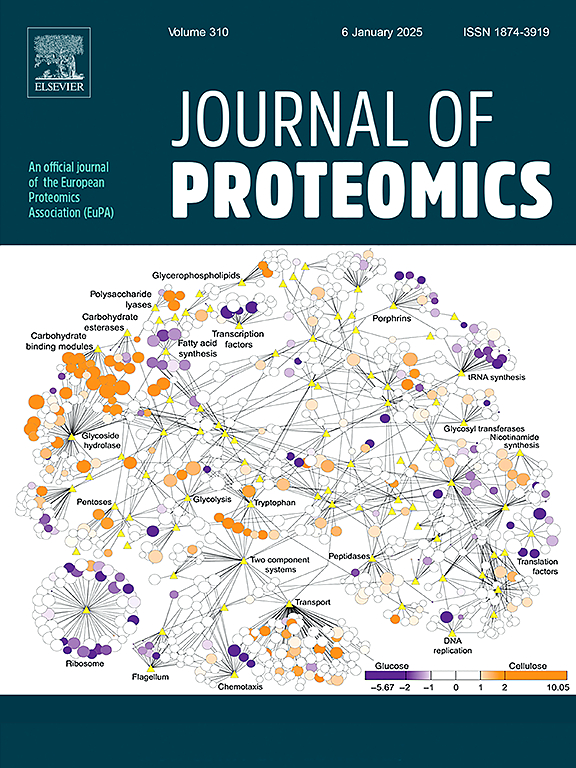尿液中对甲酚葡萄糖醛酸苷作为肾细胞癌非侵入性生物标记物的验证。
IF 2.8
2区 生物学
Q2 BIOCHEMICAL RESEARCH METHODS
引用次数: 0
摘要
肾细胞癌(RCC)是最致命的泌尿系统恶性肿瘤之一。大多数 RCC 都是偶然诊断出来的,因为最初的症状没有特异性。我们需要新型、微创的 RCC 诊断和预后方法,最好是在尿液中进行诊断。利用 UPLC-Q-ToF MS 对尿液进行非靶向代谢组分析,我们发现对甲酚葡萄糖醛酸苷是潜在的 RCC 诊断标志物。此外,肾切除术后一年的尿液样本显示异丁酰-l-肉碱和 L-脯氨酸甜菜碱是潜在的 RCC 预后标志物。我们目前的目的是在一组独立的 RCC 患者和健康对照组中验证这些差异,以加强它们作为非侵入性生物标志物的价值。在一个由 69 名 RCC 患者和 52 名对照组组成的独立队列中,我们验证了与对照组相比,诊断时患者尿液中对甲酚葡萄糖醛酸的含量有所增加(P = 0.0043)。肾切除术后一年,该数值仍在增加(P = 0.0288)。通过 ROC 曲线分析评估了对甲酚葡萄糖醛酸对诊断 RCC 的价值(AUC = 0.66,95 % 置信区间为 0.56-0.76)。异丁酰基-l-肉碱和L-脯氨酸甜菜碱作为预后标志物的作用尚未得到验证,需要更大规模的队列研究。我们的研究结果证实了尿液中的对甲酚葡萄糖醛酸苷作为RCC诊断标志物在一个独立队列中的价值。这种非侵入性方法减少了对潜在风险诊断程序的需求,有望加强对患者的护理。针对酪氨酸氧化途径的进一步元蛋白质组学方法和微生物群元组学研究可促进对 RCC 的整体管理。意义:目前用于诊断和监测肾细胞癌(RCC)的成像技术对患者有害,因为辐射剂量大,而且对低级别肿瘤没有特异性。因此,具有诊断和预后能力的新型非侵入性生物标志物至关重要。在此,我们验证了尿液对甲酚葡萄糖醛酸苷可作为 RCC 的诊断标志物。这种新型非侵入性生物标记物可以提高对肿瘤行为的准确评估,同时通过减少不适感和有害副作用来改善患者的预后。本文章由计算机程序翻译,如有差异,请以英文原文为准。
Validation of urine p-cresol glucuronide as renal cell carcinoma non-invasive biomarker
Renal cell carcinoma (RCC) stands among the most lethal urological malignancies. Most RCCs are incidentally diagnosed as initial symptoms are unspecific. Novel, minimally-invasive diagnostic and prognostic methods for RCC are needed, ideally in urine.
Using UPLC-Q-ToF MS untargeted metabolomic analysis in urine, we previously revealed p-cresol glucuronide as potential RCC diagnostic marker. Additionally, urine samples one-year post-nephrectomy revealed isobutyryl-l-carnitine and L-proline betaine as potential RCC prognostic markers. Our present aim was to validate these differences in an independent cohort of RCC patients and healthy controls to strengthen their value as non-invasive biomarkers.
In an independent cohort of 69 RCC patients and 52 controls we validated an increase in p-cresol glucuronide in urine from patients at diagnosis compared to controls (P = 0.0043). It remained increased one-year post-nephrectomy (P = 0.0288). The value of p-cresol glucuronide for RCC diagnosis was assessed with ROC curves analysis (AUC = 0.66, 95 % Confidence Interval 0.56–0.76). The role of isobutyryl-l-carnitine and L-proline betaine as prognostic markers could not be validated and will require a larger cohort.
Our findings confirm the value of p-cresol glucuronide in urine as diagnostic marker for RCC in an independent cohort. This non-invasive method holds promise for enhancing patient care by reducing the need for potentially risky diagnostic procedures. Further metaproteomics-oriented approaches towards the tyrosine oxidation pathway and microbiota metagenomics studies may promote a holistic management of RCC.
Significance
Current imaging techniques available to diagnose and monitor renal cell carcinoma (RCC) are harmful for the patient given the high-radiation dose, and unspecific in low-grade tumors. Thus, novel non-invasive biomarkers with diagnostic and prognostic capabilities are of utmost importance. Herein, we have validated urine p-cresol glucuronide as diagnostic marker for RCC. This novel non-invasive biomarker could improve accurate assessments of tumor behavior, while enhancing patient outcomes by reducing discomfort and detrimental side effects.
求助全文
通过发布文献求助,成功后即可免费获取论文全文。
去求助
来源期刊

Journal of proteomics
生物-生化研究方法
CiteScore
7.10
自引率
3.00%
发文量
227
审稿时长
73 days
期刊介绍:
Journal of Proteomics is aimed at protein scientists and analytical chemists in the field of proteomics, biomarker discovery, protein analytics, plant proteomics, microbial and animal proteomics, human studies, tissue imaging by mass spectrometry, non-conventional and non-model organism proteomics, and protein bioinformatics. The journal welcomes papers in new and upcoming areas such as metabolomics, genomics, systems biology, toxicogenomics, pharmacoproteomics.
Journal of Proteomics unifies both fundamental scientists and clinicians, and includes translational research. Suggestions for reviews, webinars and thematic issues are welcome.
 求助内容:
求助内容: 应助结果提醒方式:
应助结果提醒方式:


